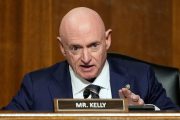As hundreds of law-enforcement personnel and forensic examiners explore the three shootings over the past week, searching for motives behind the violence, one common element keeps bubbling to the surface: anger.
It surfaced when the Garlic Festival shooter, 19-year-old Santino Legan, told a witness that he was shooting people there “because I’m really angry.” He left a clue on Instagram, referring his readers to a rancid, racist, and anti-Semitic book that was so hateful and vitriolic that it was banned for several years.
Part of the “manifesto” published by the El Paso shooter, 21-year-old Patrick Crusius, just before his rampage revealed his anger at the immigration of Mexicans crossing the border into Texas, declaring: “This attack is a response to the Hispanic invasion of Texas. They are the instigators, not me.”
The Dayton shooter, 24-year-old Connor Betts, planned his attack carefully, dressing himself in riot gear including a face mask and a bullet-proof vest. When he was denied entry into Ned Peppers Bar at 1:30 Sunday morning, he began shooting people indiscriminately, killing eight and wounding another 27 before law officers ended his rampage.
Maureen Callahan, a writer on pop culture for the New York Post, saw the link and wrote:
We know it’s a specific strain of anger — deep, repressed, biblically vengeful — felt most commonly by young men, almost always white, who report feeling alienated, dispossessed, misunderstood, victimized and all too often rejected by women.
[The shooters fit] the profile of those who’ve come before, the rage-induced young men we first encountered through Columbine and later Sandy Hook, Aurora, Charleston, Virginia Beach, the STEM school shooting in Colorado, Charlotte, the Poway synagogue shooting in California, the Louisiana shootings in two parishes, the Sebring shootings in Florida (those last six this year alone), the Mercy Hospital shooting, the Thousand Oaks shooting, the Tallahassee yoga studio shooting, the Jacksonville Landing shooting, the Art All Night shooting in New Jersey, the Santa Fe HS (Texas) shooting, the Nashville Waffle House shooting, the Marjory Stoneman Douglas HS shooting — and far too many more to mention, but all with one thing in common.
And then Callahan said this:
The ever-incubating mass shooter, these young men nurturing their anger through first-person shooter games, violent pornography, through racism and a fascination with guns and violence, is our greatest, most stubborn and pressing threat. (Emphasis added.)
Violence and Video Games
In preparing its “Year in Review” for Charisma News for 2018, Lyndee Fletcher noted 15 mass murderers who were linked to violent video games, including Chris Harper-Mercer, the shooter who murdered 10 people on the Umpqua campus, who was obsessed with violent gaming. Fletcher named the others:
1. Adam Lanza, Sandy Hook Elementary, was a frequent player of violent first-person shooter video games. It was said his existence largely involved playing violent computer video games in his bedroom.
2. James Holmes went on a rampage in a movie theater showing The Dark Knight Rises in Aurora, Colorado in July 2012, He was a frequent player of violent video games including World of Warcraft, an infamously addictive role-playing game.
3 Jared Lee Loughner, Tucson, who shot Rep. Gabrielle Giffords and killed six others in Tucson in January 2011, was both mentally ill and a video gamer.
4. Eric Harris, based on his journal, a panel of psychologists, psychiatrists and FBI agents point to Harris’s contempt for others and his total lack of empathy and conscience as evidence of his psychopathic tendencies. He also enjoyed violent video games.
5. Elliot Rodger, killed seven young men and women, including himself. He was hooked on violent video games from a young age from his own admission, hiding himself in World of Warcraft, where he felt comfortable and secure.
6. Nehemiah Griego, killed five, including his mother, father and his three younger siblings. He loved playing violent video games and even enjoyed talking about them to crime investigators.
7. Jacob Tyler Roberts, played violent video games (his rampage enacted a violent scene in Grand Theft Auto)
8. Anders Behring Breivik shot 68 people dead at a youth camp of the Norwegian Labor party, another nine in a bombing of government buildings. According to the judgment rendered against him, he liked playing violent games. He actually used the video game Call of Duty to train for his shooting massacre.
9. Michael Carneal shot girls as they prayed in a prayer group. Carneal never moved his feet during his shootings, and never fired far to the left or right, but instead fired only once at each target that appeared, just as a player of video games maximizes his game score by shooting only once at each victim, in order to hit as many targets as possible.
10. Jose Reyes, a 12-year-old boy who opened fire with a semiautomatic handgun at Sparks Middle School last October, killing a teacher and wounding two students before turning the gun on himself, had watched violent video games for months.
11. Dylann Storm Roof, spent much of his time playing violent video games.
12. Jeff Weise, a 16-year-old, shot dead nine people near his high school in Red Lake, Minnesota. He had an obsession with violent animation.
13. Chris Harper-Mercer shot dead nine people and injured another seven in a community college in southern Oregon.
14. Evan Ramsey sneaked a shotgun into his high school and shot a student and the principal and wounded two others. He claims that a video game, Doom, distorted his version of reality: “I did not understand that if I pull out a gun and shoot you … you’re not getting back up. You shoot a guy in Doom, and he gets back up. You have got to shoot the things in Doom eight or nine times before [they die].”
Fletcher assumes that these killers couldn’t distinguish between the games and reality: “[They] have a warped sense of what’s real and what’s not, thinking that real life is just a video game.”
It’s worse than that, according to Brad Bushman, professor of communication and psychology at OSU: “People who have a steady diet of playing these violent video games may come to see the world as a hostile and violent place.” And, added Bushman, there could be a “cumulative effect” in making the gamers ever more aggressive and violent the more they indulge in the digital violence.
Fletcher concludes: “The more minds are corrupted with violence, the more dangerous society becomes.”
Whether the shooters were corrupted by video games or their violence had some other cause (many shooters have been on anti-depressants, which often have the side effect of homocidal ideation), we can see cracks happening in our society, and those cracks should be taken as a warning of possible cultural collapse, something to be dealt with before it gets worse: In a speech that Abraham Lincoln made to the Young Men’s Lyceum in 1838, he noted presciently:
Shall we expect some transatlantic military giant to step the ocean and crush us at a blow? Never! All the armies of Europe, Asia, and Africa combined, with all the treasure of the earth (our own excepted) in their military chest, with a Bonaparte for a commander, could not by force take a drink from the Ohio or make a track on the Blue Ridge in a trial of a thousand years.
At what point then is the approach of danger to be expected? I answer. If it ever reaches us it must spring up amongst us; it cannot come from abroad. If destruction be our lot we must ourselves be its author and finisher. As a nation of freemen we must live through all time or die by suicide.
Image: Screenshot from callofduty.com
An Ivy League graduate and former investment advisor, Bob is a regular contributor to The New American, primarily on economics and politics. He can be reached at [email protected].
Related articles:
El Paso Mass Shooting Elicits Calls for More Gun Control
Garlic Festival Shooting: So Many Questions, So Few Answers So Far




